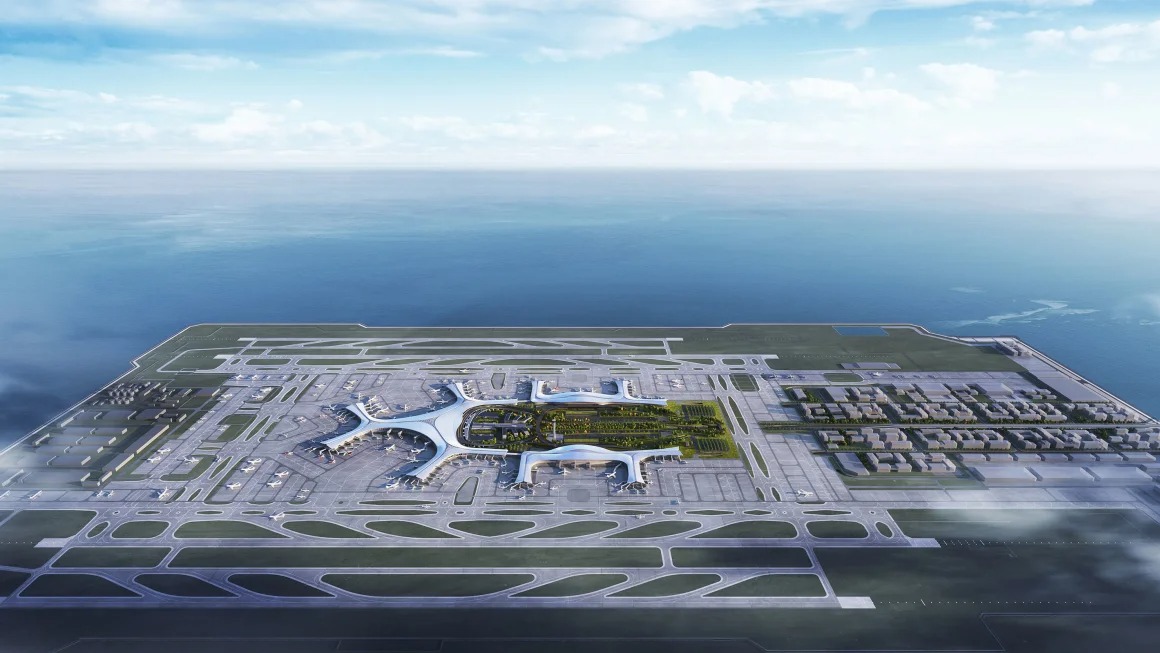China is setting yet another remarkable benchmark in the aviation world with the construction of the Dalian Jinzhou Bay International Airport, poised to become the largest airport built on a man-made island. This ambitious project highlights China’s engineering prowess and its ongoing efforts to dominate the global aviation industry.
An Engineering Marvel in Progress
The Dalian Jinzhou Bay International Airport is currently under construction off China’s northeast coast and will cover a sprawling 20-square-kilometer (7.7-square-mile) man-made island upon completion. This futuristic facility is set to include four state-of-the-art runways and a massive 900,000-square-meter (969,000 sq ft) passenger terminal, designed to handle up to 80 million passengers per year across 540,000 flights.
The project’s first phase is expected to open in 2035, marking a significant milestone in China’s aviation expansion. Operators of the airport have described the construction as a remarkable feat, with a statement on Chinese social media platform WeChat poetically comparing it to the “sunrise in the east,” as the airport gradually rises from the sea.
Surpassing Aviation Giants
Once completed, the Dalian Jinzhou Bay International Airport will surpass Hong Kong International Airport (HKG) and Japan’s Kansai International Airport (KIX) as the world’s largest offshore airport. Both HKG and KIX have been globally celebrated for their innovative designs and strategic locations, but Dalian’s new airport will take the crown with its sheer size and passenger capacity.
Challenges of Building on Water
Constructing an airport on reclaimed land is no small feat. Chief Engineer Li Xiang, of the Dalian Airport Construction and Development Co., Ltd., revealed that the project has faced significant challenges. “The project has complex geological conditions, high drilling difficulty, and high demand for quality, with a tight construction schedule,” Li told state-run local media in October.
The reclamation and development of such a massive artificial island require advanced technology and meticulous planning to ensure structural stability and operational efficiency. Despite these obstacles, China’s commitment to pushing the boundaries of engineering innovation remains unwavering.
Why Dalian?
Dalian, a city of 7.5 million people, has long been a transportation hub due to its strategic location near Japan and South Korea. The city’s current international airport, Dalian Zhoushuizi Airport, has been operational for nearly a century and has reached its maximum capacity despite several expansions in recent years.
The construction of a new airport was conceived in 2003, but it took several years of site selection and feasibility studies before the project gained momentum. With Dalian Jinzhou Bay International Airport, the city aims to solidify its status as a major gateway for international travel in Northeast Asia.
China’s Aviation Boom
The development of Dalian Jinzhou Bay International Airport is part of a broader strategy to accommodate China’s growing aviation market. The country is projected to overtake the United States as the world’s largest air travel market in the coming years.
In 2019, Beijing unveiled its second major airport, Beijing Daxing International Airport (PKX), which opened on the 70th anniversary of the founding of the People’s Republic of China. Dubbed the “starfish” by Chinese media for its unique design, Daxing International Airport was built to address the increasing demand for air travel in the Beijing-Tianjin-Hebei region.
At the time, Chinese officials announced plans to build 450 airports by 2035 to meet the needs of the growing aviation sector. Dalian Jinzhou Bay International Airport represents a significant step toward achieving this ambitious goal.
Economic and Strategic Impact
The new airport is expected to have a transformative impact on Dalian’s economy and its role in global trade. With its enhanced passenger and cargo-handling capabilities, the airport will likely attract more international airlines and businesses to the region.
Moreover, its strategic location on the northeast coast makes it an ideal hub for connecting Asia with Europe and North America. The airport’s advanced infrastructure will also support China’s Belt and Road Initiative, facilitating trade and tourism across borders.
A Glimpse into the Future
While the airport’s first phase is still more than a decade away from completion, its construction symbolizes China’s relentless drive to innovate and lead in the global aviation industry. As the world’s largest artificial island airport, Dalian Jinzhou Bay International Airport will set new standards for infrastructure development and technological achievement.
The Broader Vision
China’s commitment to expanding its aviation network is not limited to Dalian or Beijing. The country’s aviation growth strategy reflects its broader vision of becoming a global leader in transportation and connectivity.
From high-speed rail networks to world-class airports, China continues to invest heavily in infrastructure to support its growing economy and global ambitions. The Dalian Jinzhou Bay International Airport is just one example of how the country is leveraging its engineering expertise to build a future-ready transportation network.
The Dalian Jinzhou Bay International Airport is more than just an airport; it’s a testament to China’s ability to tackle complex engineering challenges and create world-class infrastructure. Once completed, it will not only revolutionize air travel in Northeast Asia but also set a new benchmark for airport construction worldwide.
With its massive capacity, strategic location, and cutting-edge design, the airport will play a key role in shaping the future of global aviation. As the project moves forward, the world will be watching closely to see how China continues to push the boundaries of what’s possible.





























